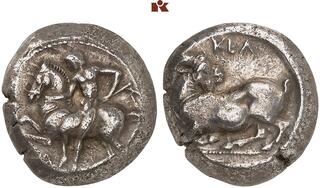| Fritz Rudolf Künker GmbH & Co. KG > Auction 402 | Auction date: 14 March 2024 |
| Lot number: 422 Price realized: 320 EUR (Approx. 348 USD) Note: Prices do not include buyer's fees. | Show similar lots on CoinArchives Find similar lots in upcoming auctions on |
| Lot description: CILICIA. KELENDERIS. AR-Stater, 425/400 v. Chr.; 10,58 g. Reiter l. mit Peitsche, zwischen den Beinen des Pferdes A//Ziege l., zurückblickend. Kraay in NC 1962, 1; SNG France 2, -; SNG Levante vergl. 18. Min. korrodiert, kl. Schrötlingsrisse, sehr schön Kelenderis (früher nach dem antiken Stadtnamen Gilindere, heute nach der Türkisierung des Ortsnamens Aydıncık) liegt auf halber Strecke zwischen Anamur und Silifke (Blumenthal 1963, 109). Die Stadt war dem Mythos nach die Gründung eines gewissen Sandokos, der aus Syrien gekommen sein soll; wahrscheinlich ist damit phönikischer Einfluss gespiegelt (Apollodor, Bibliotheke III 181; Casabonne 2000, 46 f.). Die Stadt verstand sich aber mindestens seit der Mitte des 5. Jhdts. v. Chr. als eine Gründung von Samos (Pomponius Mela, De chorographia, I 77) und wurde deshalb zeitweilig als Mitglied des Delisch-Attischen Seebundes (478-404 v. Chr.) in den Tributlisten geführt (Meiggs 1975, 102). In dieser Zeit setzt auch die Münzprägung ein. Deshalb ist es nicht verwunderlich, dass die Stadt Wert auf eine noch frühere griechische Gründung legte und sich mit Bellerophon in Verbindung brachte, von dem auch weitere Aktivitäten in Südkleinasien (Chimaira; Tarsos) gut bezeugt sind. Er ist der Reiter, der auf den Vorderseiten der Statere dargestellt ist (Nr. 422-426). Das Pferd, das er reitet ist der Pegasos. Das macht jenes Obolenteilstück klar, dass das Vorderteil eines Pferdes mit Flügeln zeigt (Nr. 428). Das Taurusgebirge war die Heimat schneller Pferde (vgl. etwa die Prägungen von Termessos, Aspendos, Seleukeia); möglicherweise brachten die Bürger von Kelenderis den Stadtnamen mit dem griechischen Wort für Rennpferde (keletes) in Verbindung (Kraay 1976, 279). Im Gründungsmythos von Kelenderis war anscheinend die Rede davon, dass Bellerophon die schnellen Bergziegen (Bezoarziege/Paseng), die die Felder und Weinberge der Kelenderiten abfraßen, erfolgreich jagen konnte. Damit stellte er unter Beweis, dass er auf einer schmalen Küstenebene im wilden Rauen Kilikien eine Stadt gründen konnte (Nollé 2005, 190-193). Ein Delphin im Abschnitt eines Staters (Nr. 426) weist auf die Bedeutung des Hafens für die Stadt hin, die häufiger vorkommenden Efeublätter – Attribute des Dionysos – spielen auf den Weinbau von Kelenderis an. Mehrere schöne Statere von Kelenderis – alle aus der 2. Hälfte des 5. Jhdts. v. Chr. – sind in die Sayar-Sammlung eingegangen. Darunter befindet sich auch ein sammlungsgeschichtlich interessantes Exemplar (Nr. 426), das aus der Sammlung Hans von Aulocks stammt, dann aber in die Kollektion des bedeutenden Kilikiensammlers Edoardo Levante überging, ehe es in die Sayar Collection gelangte. [JN] Kelenderis (formerly called Gilindere after the ancient city's name, today using the Turkish toponym Aydıncık, i.e. 'bright place') lies halfway between Anamur and Silifke (Blumenthal 1963, 109). According to myth, the city was founded by a certain Sandokos, who is said to have come from Syria; this probably reflects Phoenician influence (Apollodorus, Bibliotheke III 181; Casabonne 2000, 46 f.). However, at least from the middle of the 5th century BC, the city saw itself as having been founded by Samos (Pomponius Mela, De chorographia, I 77) and was therefore temporarily listed as a member of the Delian League (425 BC) in the so-called Athenian tribute lists (Meiggs 1975, 102). Around this time, Kelenderis began to mint coins. Therefore, it is not surprising that the city attached importance to portraying itself as having been founded even earlier and associated itself with Bellerophon, whose activities in other parts of southern Asia Minor (Chimaira; Tarsos) are well documented. He may be identified as the horseman depicted on the front of the staters (Nos. 422-426). The horse he is riding is the Pegasus. This is made clear by obols that show the front part of a horse with wings (No. 428). The Taurus Mountains were home to fast horses (cf. coins of Termessos, Aspendos, Seleukeia); the citizens of Kelenderis possibly connected the city's name with the Greek word for racehorses (keletes) (Kraay 1976, 279). According to the founding myth of Kelenderis, Bellerophon was said to have successfully hunted the fast mountain goats (bezoar goat/paseng) that damaged the fields and vineyards of the people of Kelenderis. With his successful hunting, Bellerophon proved that he was capable of founding a city on a hill near a narrow coastal plain in Cilicia Trachea (Nollé 2005, 190-193). A dolphin depicted in the coin's exergue (No. 426) indicates the importance of the harbor for the city, while the more frequently occurring ivy leaves – attributes of Dionysus – allude to the viticulture of Kelenderis. Several beautiful staters from Kelenderis – all from the 2nd half of the 5th century BC – have entered the Sayar Collection. Among them is an interesting specimen (No. 426) from the Hans von Aulock Collection, which then was incorporated into the collection of the important collector of Cilician coins, Edoardo Levante, before it became part of the Sayar Collection. [JN] Estimate: 250 EUR |  |



